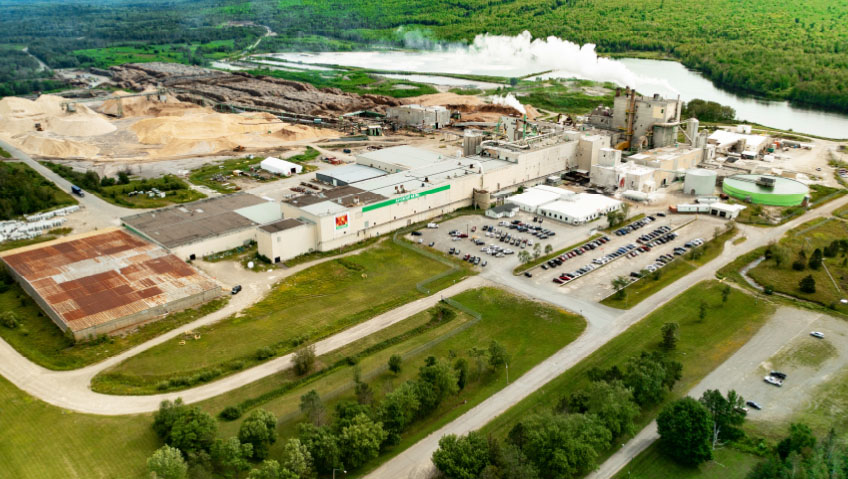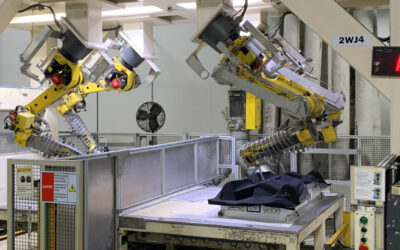If you’re wearing apparel that drapes and flows beautifully, with a luxurious silk-like sheen and bearing a label from any number of popular international brands, you may be surprised to learn it began life in a forest in New Brunswick, sustainably managed by AV Group, and processed in a dissolving-grade pulp mill, also owned by the AV Group.
Or, if you’re choosing to purchase high quality tissue products, manufactured in the U.S., you may be equally surprised to learn they too began life in a forest, not in New Brunswick, but in northern Ontario, and processed at an AV Group-owned mill in Terrace Bay on Lake Superior.
Integrated supply chain management, superior quality products, sustainability – AV Group Canada, Inc., with a corporate office in Fredericton, NB, and pulp mill operations in Atholville and Nackawic, NB and Terrace Bay, Ontario, is ticking all the right boxes.
Mike Legere, the company’s Director of Government Relations and Communications, describes the path to success of the ubiquitous AV Group, which is the Canadian presence of the Aditya Birla Group of Mumbai, India.
Iconic history
The lineage of the AV Group can be traced back to no less a luminary than Mahatma Gandhi. This deeply revered visionary was well connected with India’s business community and felt strongly that it was essential for a nation to be economically self-sufficient – to be able to feed and clothe all its citizens.
Gandhi was a close confidante of G. D. Birla, the foremost industrialist of pre-independence India. Gandhi’s ideas about the economy may well have influenced Birla to research and develop methods of producing cellulosic fibre from plants other than cotton. This was when the formation of the new state of Pakistan was threatening the supply of raw cotton that fed India’s mills.
And so it was that 75 years ago the Aditya Birla company formed a subsidiary, Grasim Industries Limited, just as India gained independence from Great Britain in August 1947 and underwent the traumatic process of partitioning.
In the beginning Grasim used bamboo as its main resource for the production of cellulosic fibre (MMCF), but later began using hardwood to produce viscose staple fibre (VSF).
Today, Grasim Industries Limited is the parent company of AV Group and the flagship company of the Aditya Birla Group. Legere describes Aditya Birla, led by K. M. Birla, great-grandson of G. D. Birla, as a global conglomerate with annual revenues of over $48 billion. More than half of this revenue comes from 50 overseas companies established in 36 countries in five continents. The group has over 140,000 employees representing 42 nationalities.
What’s remarkable about the company, Legere shares, is that it “strives to be in the top three of any industry it has invested in, including agri-business, cement, telecommunications, carbon black, aluminum rolling, textiles, and the pulp and fibre business, in which it is first in the world, and of which the AV Group is an integral part.”
From deep in a forest
As Grasim Industries grew, it needed to solidify its supply chain. It turned its attention to the six million hectares of forestland in New Brunswick, comprising coniferous (softwood), mixed, and deciduous (hardwood) forests, with the latter containing a plentiful supply of the preferred grey bark species, including aspen, maple and birch.
Thus, AV Group was formed as one of four companies in the province licensed to manage forests, on crown lands as well as on industrial free-hold land, and harvest wood from them.
“When we speak about an integrated supply chain, it starts with us,” Legere explains. “We have control over the actual trees, how they grow, and what supply there will be for the future. Our professional foresters look 80 years ahead, to make sure we are managing our supply to have a sustainable input for our mills.”
But that’s only half the New Brunswick story as the harvested wood has to be processed into dissolving-grade pulp. This was achieved by the company’s acquisition of a pulp mill in Atholville on the Quebec border in 1998.
Then, in 2006, the company acquired a second kraft pulp mill in Nackawic on the Saint John River, 60 km northwest of Fredericton, site of the corporate office.
Both mills were facing serious market issues when Birla bought them up, with the Nackawic mill in receivership. Grasim invested heavily to convert them to dissolving-grade pulp mills to supply the required product for viscose staple fibre production which is one of several steps in fabric production.
“For dissolving pulp the cooking process differs from regular pulp,” Legere tells us. “It’s a chemical process where we cook a mixture of hardwood pulp species in the digester at the Nackawic mill, while the Atholville mill (AV Cell) processes about a 50/50 mix of softwood and hardwood.” The precise cooking process is what differentiates products such as viscose, lyocell, and modal.
The two New Brunswick mills combined produce about 300,000 tons of dissolving-grade pulp annually, which exits the mills in the form of two-foot square sheets resembling thick, coarse blotter paper, baled and unitized for container transport.
From there, it’s transported to the ports of Saint John and Halifax, and shipped in containers to Grasim-owned facilities in India, China, Thailand, and Indonesia. There the bales of cellulose are dissolved, reconstituted into VSF and sent down the supply chain to be spun into thread, and woven into cloth, before going to apparel and home-textile manufacturers, and finally, to retail outlets.
Since its establishment in New Brunswick, the Birla Group has added a dissolving-grade pulp mill in Domjo, Sweden (2011) and the kraft mill in Terrace Bay, Ontario in 2012.
This latter has remained as a traditional kraft pulp mill producing over 350,000 tons of northern bleached softwood kraft (NBSK).
The company ships this primarily by rail to customers throughout the U.S. midwest and as far south as Georgia and Florida, where it is converted into a variety of personal hygiene and domestic tissue products and graphic paper.
Superior products
Legere says that what makes clothing and domestic textiles produced from New Brunswick forests and mills superior is the abundance of maple wood and the cellulose extraction abilities of the mills, which is important because the quality of the product depends on the purity of the alpha cellulose.
Extremely high-grade alpha cellulose goes into Birla Modal, which is more expensive than other forms of the fabric and highly sought after by fashion designers for its natural fluidity. “Birla Modal is particularly good,” he says, “because it holds colour fast, it drapes the nicest of any material, and with its high lustre it’s the closest to actual silk but performs better.”
Other products include Birla Excel and Birla Viscose made from cellulosic fibre provided by AV Group and which go into both woven and non-woven products. Manufacturers use these in a wide variety of apparel items – pants, shirts, denims, knitwear, and more utilitarian items such as uniforms. The woven fabric is also used in home textiles, including bed and bath linens, furnishings and floor covers.
“Eventually,” he says, “some will return to North America in the form of a recognizable fashion house or brand, such as Target, Marks & Spencers, Bed, Bath & Beyond, Victoria’s Secret, Gap, Tommy Hilfiger, or J. C. Penney. All those are key brands that use Birla Cellulose products.”
Meanwhile, non-woven VSFs, branded under the Birla ‘Purocel’ line, are used in medical textiles, such as surgical gowns and masks, linens to cover patients, disposable diapers, and various types of wipes. “In fact, they’re used in a whole myriad of industrial products, including filter material,” he says.
Changing the focus to tissue and the superiority of the product that the Terrace Bay kraft mill supplies to U.S. manufacturers, Legere indicates that tissue quality depends on the quality of the pulp that goes into it and the mix of hardwood for smoothness and softwood for strength.
“Our native black spruce in Ontario’s boreal forest is well-suited in terms of the strength of the fibre extracted from it. And most of the wood chips used are residual by-products of sawmills producing lumber, so we contribute to full utilization of the forest resource – no waste.” Legere adds that, “Recycled content in tissue is a consumer option but there is a quality impact on the end product as fibre quality degrades the number of times it is repulped.”
Sustainable outcomes
Legere explains that, “Sustainability is key to every aspect of the supply chain, starting with the woodlands.”
In New Brunswick the forests which supply wood to the mills in Atholville and Nackawic are sustainably managed by AV Group, which employs professional foresters and manages forests to supply wood to dozens of other mills as well across the province.
In Ontario, AV Group contributes to the management of many of the forests which supply the Terrace Bay mill through a unique First Nation-industry partnership, Ogwiidachiwaning Sustainable Forest Management (OSFMI). It is a corporate body composed of First Nations and forest sector companies that manages nearly two million hectares of the Kenogami Forest, under FSC certification, on the shores of Lake Superior.
Legere describes this as an important business relationship that was years in the making and demonstrates meaningful economic reconciliation with First Nations. “The inclusion of indigenous knowledge and perspective into our forest management strengthens sustainable outcomes.”
AV Group has received third party certification from the Forest Stewardship Council (FSC) and Sustainable Forest Initiative (SFI). It holds both forest management and chain of custody certification from those international organizations, and has particularly focused on increasing its number of FSC chain-of-custody certifications.
“The latter, chain of custody, is important because we purchase wood from outside companies, and we need to ensure sustainability of the source of our supply externally as well as internally,” he says. Taking this further upstream, the Birla ‘Livaeco’ brand of fabric uses a molecular tracer and block chain technology to trace the origins of a garment all the way back to the forest and how it was managed.
“Sustainability starts in the woodlands, but it moves up through the pulping process, where we are regulated in terms of emissions and reduction of our carbon footprint. We derive, on average, for all sites, about 90 percent of heat and power from renewable energy sources,” says Legere.
Taking responsibility to the next level
“We also recover most of our pulping chemicals through a closed loop recovery boiler system and reuse non-contact water [water that has not been mixed with any chemicals but rather used for process cooling] which is standard procedure today in the industry.”
These careful procedures and emphasis on responsible use are a source of pride, not only for the woodlands team, but also for the AV Group and parent company Grasim, allowing them to brand end products as sustainably sourced.
“We want to give people confidence that the shirt or blouse they’re wearing, or the towel in their bathroom, was produced sustainably from both an environmental and a governance standpoint,” he says.
Moreover, not only are the apparel and home textile products sustainably sourced, unlike synthetics manufactured from fossil fuels, but they are biodegradable and so will not create long-lasting environmental problems.
The Birla Group has received a number of accolades and recognitions for sustainability; has been recognized by the UN for its VSF operations in India; and in 2021, was again recognized as Number 1 in the Hot Button Report from Canopy, an environmental, non-profit organization that rates companies that produce MMCF. Meanwhile, AV Group has been rated one of the top employers in Atlantic Canada (2017) and included in the Career Directory’s list of Canada’s Best Employers for Recent Graduates (2020).
This must surely be a direct result of the company’s mission to pursue excellence in people, process, and product by providing training and education opportunities, technological advances, and community partnerships.













